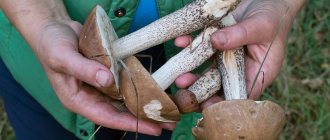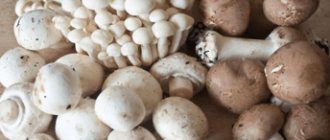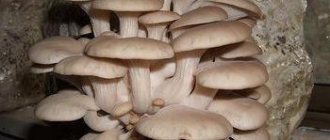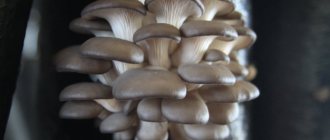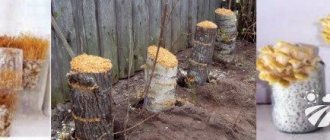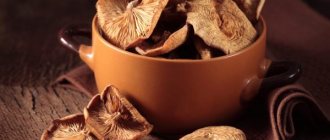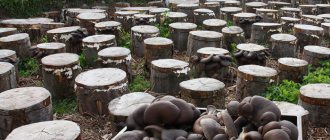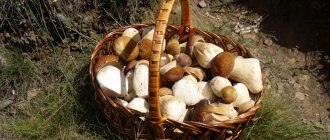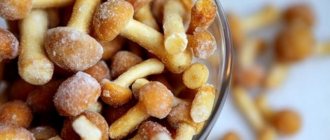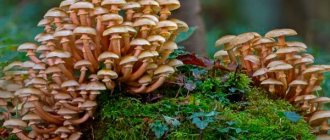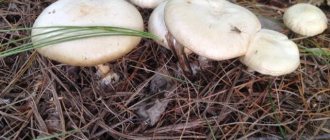Why honey mushrooms
Honey mushrooms are quite tasty mushrooms that can be grown not only in your summer cottage, but also on your balcony. The main thing is to follow the germination and planting technology. These mushrooms have tender and aromatic flesh. Honey mushrooms are often used to prepare soups, stir-fries and various sauces. After all, the product retains its unique aroma even after heat treatment.
In addition, growing honey mushrooms is an activity that can bring good income. In Slovakia, the Czech Republic and Germany they often engage in similar business. However, in these countries a special paste is used as planting material. It is not yet possible to purchase such a substance in our stores.
Possible difficulties
One of the frequently encountered difficulties when growing honey mushrooms at home is the rapid spread of spores and their contamination of healthy wood. In outdoor conditions, this problem is solved by organizing a trench. If cultivation is carried out indoors, then a special place must be allocated for mushrooms.
If you plan to breed honey mushrooms on a large scale, then a separate room (plot, greenhouse) should be allocated for them. If the necessary conditions are properly organized, growing mushrooms can become a good business.
The difficulty in growing honey mushrooms also lies in the need to maintain a certain temperature and humidity. The easiest way to organize such conditions is in greenhouses. In an apartment, the need to comply with technology can cause some difficulties.
Honey mushrooms are valued for their taste. The unpretentiousness of these mushrooms allows you to grow them at home. This can be done in different ways. To get a good harvest, you must follow the growing rules.
0
0
Copy link
Selection of planting material
Growing honey mushrooms on stumps is a simple but long process. The main thing is to choose the right type of wood. Summer honey mushrooms germinate best on birch stumps. This material retains a large amount of moisture even after cutting. At the same time, the dense bark protects the wood from drying out.
If mushrooms are planted in the garden, then it is worth using the stumps of old pear and apple trees for these purposes. Honey mushrooms also grow well on alder, aspen and poplar logs. It is worth considering that honey mushrooms are capable of destroying any stump in 6 years.
You should not use pine and spruce to grow this type of mushroom.
Application
Summer honey mushrooms are fragrant and tasty. They can not only be pickled, but used for julienne, salads, soups and mushroom sauces. We also started collecting mushroom recipes; we could not have imagined such a variety of dishes from forest delicacies before. But I want to share the simplest, but very tasty dish, “Honey mushrooms in sour cream sauce.” Cook a kilogram of honey mushrooms for twenty minutes. Sauté finely chopped onion in butter. Add mushrooms there and fry, and then two glasses of fat sour cream and half a glass of water. Add spices and simmer until creamy sour cream. Our dish is ready! Fast, budget-friendly and, as they say, finger-licking good.
Not only have we begun to treat ourselves more often and treat our guests to mushroom dishes, but our cellar now pleases the eye with even rows of jars of honey mushrooms! Now we’ll definitely live until mid-spring with crispy mushrooms. We also started to think about launching our own mushroom production. Several greenhouses and a mushroom grove will provide the mini-factory with a sufficient amount of forest raw materials. Such natural delicacies will always be in demand by people, why not try to create a “Honeycomb Empire”.
Preparation and planting
How to grow honey mushrooms in the country? First you need to infect the old stump with fungal spores. It is not difficult. To do this, you will need the caps of already mature mushrooms. They must be laid out with the plates down on a clean sheet of paper. Spores should be pouring out of the caps. They look like dark dust. It is recommended to pour the spores into a bottle of water and shake well.
It is also worth preparing the stump itself in advance. It is worth sawing off a round piece of wood, the thickness of which should be from 3 to 5 centimeters. After this, the upper part of the stump must be cut crosswise. This can be done with an axe. The more cracks that form, the better.
Now all that remains is to infect the stump with spores. This is done quite simply. It is necessary to water the prepared wood with water containing honey mushroom spores. After this, it is worth nailing on top the round timber that was sawed off from the stump.
If the weather is dry, it is recommended to regularly water the wood infected with spores. Otherwise, honey mushrooms will not germinate.
Honey mushrooms: what kind of mushrooms are they?
The very name “honey agaric” indicates the place where the fungus grows (logs, stumps, large branches) . They are often considered parasitic organisms that infect and slowly destroy wood. Under natural conditions, honey mushrooms grow in large colonies on old, damaged trees and stumps.
The mycelium begins to bear fruit in the fall, and you can get results before frost.
Honey mushrooms are an edible variety of mushrooms characterized by high nutritional characteristics. In addition, they contain many biologically active elements, vitamins and amino acids, which allows their use in scientific medicine and pharmacology.
Breeding honey mushrooms artificially does not require any specific training or deep knowledge - any beginner can cope with it. You just have to follow the recommendations and follow the instructions.
Did you know? Artificial cultivation of honey mushrooms began several centuries ago in Japan. This crop was called “enokitake” - a Japanese winter mushroom.
Germination in bags
Since not everyone is able to grow honey mushrooms in the countryside using the first method, it is worth thinking about germinating them in a greenhouse. To do this, half-rotten pieces of wood should be placed in the corner of the structure. They also need to be watered with water that contains honey mushroom spores. After some time, the wood should be transferred to bags and placed in a dark place in a woodpile. In spring, the ends, as well as those places where the bark was damaged, should be covered with mycelium. The material is ready for planting.
Using spores
Honey mushroom spores for cultivation can be purchased at the store, or you can prepare them yourself. To do this, pick off the darkest mushroom caps. Place them in a jar, fill with clean water and leave to infuse for 12 hours. Then the caps are rubbed into a paste by hand. The entire solution is filtered and poured over stumps, logs, etc. Then cover the watered area with damp moss. Disputes will germinate for a long time. You will be able to harvest only after one or two years. After the mycelium has grown, part of it can be separated and planted in another place.
When buying spores in a store, be careful. The packages must be stored in the correct conditions, otherwise the spores will die and there will be no mushrooms.
Whatever method you choose, remember that for proper cultivation of honey mushrooms you need high humidity and a temperature within 10-25 degrees.
How to grow honey mushrooms in the country from mycelium
The wood on which the mycelium has appeared must be placed in the place where honey mushrooms are planned to be planted. This should be an area well protected from wind and direct sunlight. Winter and summer honey fungus is germinated in this way. The mycelium of the fungus must penetrate the soil. From there it will receive additional moisture. Therefore, it is recommended to dig chocks with mycelium into the soil 2/3 of the height. The distance between the pieces of wood should be from 10 to 15 centimeters.
In order for winter or summer honey fungus to germinate, it is necessary to regularly water the chocks. This is especially true in dry and hot weather. It is recommended to water the workpieces for 5 minutes once an hour. In this case, the wood needs to be moistened from 12 to 17 hours of the day. By night the logs should dry well.
Under what conditions do mushrooms grow?
Conditions for the growth of honey mushrooms are easy to arrange both at home and in a summer cottage or garden. The best time for planting planting material outdoors is in April-May or August , and in the house (warm balcony, basement) throughout the year.
Honey mushrooms are considered the most delicious and aromatic mushrooms
The air temperature at different stages of growth should be from +10 to +25°C.
With a uniform and high level of humidity, the mycelium develops quickly, which has a beneficial effect on the growth of mushrooms. The building should be well ventilated, this could be a window or built-in ventilation. The light needed for mushroom growth is not bright; it can be grown in almost semi-darkness. Only then will the caps of the mushrooms be pale, but this will not affect their taste. At the dacha, it is better to choose a shady place for planting honey mushrooms so that the wood on which the mycelium is located does not dry out.
Method three
To grow honey mushrooms on your site, you need to collect mature mushroom caps. It is recommended to place them in a container and fill them with water. The hats should sit for several days. After this, the water from the container should be drained and filtered. The resulting infusion must be soaked in pre-prepared pieces of wood or stumps. In addition, ripe honey mushroom caps can be placed on the surface of the material. After two days they can be removed.
It is worth noting that this method is not suitable for everyone, since the germination process is very slow. The first harvest of honey mushrooms planted using this method can only be obtained by the end of the next season.
Growing in glass jars
A small amount of honey mushrooms can be grown in simple glass jars. There are many recipes for preparing the substrate. The simplest one is to take 3 parts sawdust and 1 part bran. The mixture is soaked in water for a day. The finished mass is squeezed out and placed in jars. Mold poses a particular danger to the substrate. So that the work is not in vain, jars filled with sawdust are immersed in hot water for 1 hour for sterilization.
When the substrate has cooled, holes are pierced with a stick, and honey mushroom mycelium is populated inside. A layer of damp cotton wool is placed on top. The jar is closed with a lid with ventilation holes. In a month, the substrate will be overgrown with mycelium. After another 20 days, mushrooms will appear. When the caps reach the lid, it is removed. The jars are placed in a warm, shaded, humid place. After harvesting the first wave of the crop, the next honey mushrooms will grow in 20 days.
Germination of mycelium
There is also a less labor-intensive way to germinate honey mushrooms. This will require not only rotten stumps or logs, but also mycelium. The growth of summer honey mushrooms is more intense. You can find mycelium in the forest. This needs to be done in early June. You should only take the area where active mycelium growth is noted. As a rule, in such places you can see a large number of threads that have a cream or white tint. In addition, there should be a strong smell of mushrooms. The mycelium should be collected together with pieces of wood.
Such blanks must be placed in notches on logs or stumps. To prevent the mycelium from dying, it is recommended to cover the planting site with shingles, moss or bark. For better germination, the stump or log should be covered with film. This method allows you to get the first harvest of mushrooms by the beginning of the next season. It is best to infect wood with summer honey fungus in the fall or early summer.
Breeding on stumps
If you have a small area where birch or spruce stumps remain, it can be used for growing honey mushrooms. But not just any stumps are suitable for this - the wood must be dense, not damaged by bark beetles and not rotten from age. The stumps must be damp. The permissible level of humidity can be determined by the rich dark color of the cut and the release of liquid from a small chopped piece. Moreover, it is important that the stump is wetted to the very core, and not just from the outside.
To moisten the stump yourself, water it generously 1-2 days before sowing the mycelium of the honey fungus. Pour cold water in buckets or hose in small portions so that the water has time to soak into the wood.
Sowing from fruiting bodies
Seed material, that is, the mycelium itself, is ordered on the Internet or found independently in the forest. You can take the fruiting bodies themselves, as well as small pieces of wood affected by mycelium.
How to plant mushrooms if you are using the fruiting body of the honey mushroom:
- Select exclusively overripe mushroom caps with a diameter of 8 to 12 cm. The underside of the caps should be dark brown.
- Select 10-20 caps and place them in a bucket of natural, non-chlorinated water. Tap water or water from quarries or other standing sources is not suitable in this case.
- Leave the mushrooms in the water for a day.
- Mash the caps with your hands without removing them from the water to form a mushy mass.
- Stir the resulting solution thoroughly and filter it through several layers of gauze.
- This way you will get a chatterbox of spores, which you need to water the prepared stumps with. To increase the area of infection, make small depressions on the vertical surfaces of the stumps and also pour the infusion there. It is best to make the recesses in a checkerboard pattern so that the mushrooms do not interfere with each other’s free growth. In one small stump it is enough to make up to 10 such notches.
- Seal the holes with damp sawdust or moss collected from the forest. This way you will ensure maximum moisture retention. The ends of the stumps should be left open.
On average, one stump should require up to 1 liter of spore talker. The spores will “hatch” slowly, and the first harvest will appear no earlier than 1.5-2 years after sowing. Such honey mushrooms bear fruit on stumps for 5 years. During this time, the stump is usually completely destroyed, after which the fruiting bodies move to the ground and attach to the large roots of nearby trees.
You can grow any type of honey mushrooms in a similar way, but if you are going to cultivate a summer variety, it is best to select stumps from deciduous trees (birch, aspen, poplar). On conifers, the mycelium develops much more slowly. Mushrooms can be planted from May to August.
Helpful advice: to fill all the cavities with spore infusion as quickly and easily as possible, use a regular enema or syringe. The minimum diameter of the stump or trunk of a dead tree that you will infect must be at least 15 cm.
Sowing from mycelium
Most professional mushroom growers prefer to infect wood with mycelium particles. Unlike sowing with spores, honey mushrooms grow much faster, and the first harvest can be harvested the following year.
You can find mycelium in the forest on almost rotten stumps. If you come across a place where a lot is growing again, choose the most pronounced area of mycelium development - it can be identified by the abundance of light cream threads and a rich mushroom aroma.
How to grow honey mushrooms from mycelium:
- Find a mycelium in the forest and separate a piece from the stump. Divide it into several small parts measuring about 1x1 cm or 2x2 cm.
- In the hemp intended for growing mushrooms, make recesses on the sides - a couple of pieces at the ends and up to 7 pieces on the vertical sides. Determine the size of the recesses in accordance with the pieces of wood brought from the forest.
- Sink pieces of grafting wood into the holes and cover them with sawdust or moss. To easily push sawdust into the recess, pour it onto a sheet, bring it to the stump and tamp it down with a stick or ruler.
- Cover the end part of the stump with a piece of thick polyethylene and press it down with a stone so that it does not blow away in the wind. The film will maintain the proper level of humidity inside the stump.
- With the onset of cold weather, cover the infected stumps with spruce branches.
- In the spring, when the snow begins to melt, make sure that melt water gets on the ends of the stumps as little as possible. It can dramatically change the acidity of the environment inside the stumps and harm developing fungi. If excess water gets inside, fruiting will be delayed for a month or longer. Therefore, with the onset of spring, it is better to immediately shake off the snow from the spruce branches.
- Spruce branches should be removed just before fruiting: in early June for summer mushrooms, and at the end of July for autumn ones.
Important: Honey mushrooms are known for their pronounced parasitic characteristics, so it is important to ensure safety measures when growing them on the site. Otherwise, the fungi can infect fruit-bearing crops. Dig a trench at least 30 cm deep and 10 cm wide at a distance of 2 m around the infected stump.
Features of cultivation
The technology for growing honey mushrooms in the country is quite simple. However, there are some peculiarities. Such mushrooms should be covered with breathable material. If desired, you can knock down a loose box from boards, agrill, or slab. Burlap or paper is also suitable for these purposes.
If the stumps remain from a freshly cut tree, then they do not need to be further processed. You can immediately begin infecting them with honey mushroom spores. If the upper part of the stump is dry, then it needs to be soaked. To do this, the wood is regularly watered for several days. Spores are planted only after the material has collected enough moisture.
If planted correctly, the first honey mushrooms should appear in June. They are usually harvested before September. However, it should be noted that in the first year there will be few mushrooms. The yield of honey mushrooms largely depends on the degree of growth of the mycelium, the quality of the wood and weather conditions. In the second year, the number of mushrooms can increase 4 times.
If honey mushrooms are planted in the garden, then you should choose a dark place where the sun's rays do not penetrate. If the stump is not located in the shade, then it is recommended to cover it. For this you can use hay or straw.
Growing honey mushrooms in a damp basement or cellar
The best way is to grow honey mushrooms in the basement using substrate blocks. Mushroom pickers make them themselves. Take a plastic bag, fill it with small straw, sawdust, and husks from sunflower seeds. The substrate is first steamed with boiling water for about 12 hours. Hot water destroys spores of parasitic fungi, weed seeds, and bacteria. It turns out to be a kind of compost for mushrooms.
The finished mass is packaged in bags. The substrate is laid in layers, sprinkling mycelium between them. The filled bag is tied with a rope at the top, placed in the basement on a rack or hung from a crossbar. The weight of one bag of substrate can vary from 5 to 50 kg, depending on its size.
After three days, cut 5 cm long slits on the bags on the convenient side with a knife. Germination of honey mushrooms will begin in about 20 days. From this period, good ventilation and lighting are provided in the basement and the air temperature is maintained at 15°C.
Basement, bag, sawdust
For growing in a basement, garage, hangar, cellar - any closed, cool room, the most suitable method is planting in bags filled with sawdust mixture.
- To fill one two-liter bag you will need 200 g of dry sawdust. You can take pine and all deciduous trees, just don’t use oak.
- 30% of the substrate should be fillers, such as barley, barley oats, buckwheat or sunflower husks. Also add a teaspoon of chalk to the mixture.
- Everything is mixed dry and soaked in water for an hour.
- Then, in the same water, the substrate must be sterilized for ¾ hour by boiling.
- After draining the excess water, place the mixture on a baking sheet and dry it in the oven for about 20 minutes (low heat).
- Then the substrate, which must remain moist, is cooled and packaged in two-liter thick plastic bags.
- The mycelium, which must first be divided into small fragments with clean hands, is poured into a bag on the surface of the sawdust, about 20 g each.
- The mycelium is covered with cotton wool and the bag is tied.
All this equipment is transferred to the basement or cellar. The temperature must be between +12°C and +20°C. You don't have to touch the packages for a month. Then bumps should form on the surface, in places where the fruiting bodies of future mushrooms form.
At this time, the bags are untied and the cotton wool is removed. Mushrooms will grow in the direction where the air flow comes from. To keep the legs short, additional lighting will be needed.
If you make holes in the bag in the places where the fruiting bodies have formed, honey mushrooms will grow from there, but the bag will resemble a hedgehog, whose needles stick out in all directions, so it will be inconvenient to collect them.
Growing honey mushrooms at home or in the country is an interesting and rewarding activity. These mushrooms do not require complex care or special conditions. They grow on their own, actively and abundantly bear fruit, and the quality and taste are not inferior to, even superior to, the taste of wild mushrooms. You can grow many mushrooms at home. Champignons, oyster mushrooms, chanterelles, even white ones. But the most productive of the forest species when grown artificially are honey mushrooms.
Laying sticks infected with honey fungus mycelium
The bookmarking process looks like this:
- Place the logs prepared for planting on a clean surface (polyethylene or clean concrete floor) so that no dirt gets into the holes during the planting process.
- Before handling chopsticks, you should wash your hands thoroughly with soap.
- Place the sticks with mycelium in the holes until they stop.
- Pour a teaspoon of potato starch diluted in water into each hole, prepared at the rate of 40 g of starch per 1 liter of water - this will stimulate the development of the mycelium.
- The hole should then be immediately sealed with wooden pegs specially prepared for this purpose. Some gardeners advise covering them with garden varnish.
Now the logs with embedded mycelium are ready to be installed in the garden plot.
Preparing the logs
Our honey mushrooms will grow not on a stump, but on a log that needs to be prepared for them. It is best to choose logs that are not very large, within 20-25 cm in diameter.
As for the length, you can determine it yourself; it’s not that important. Birch or oak are best suited for honey mushrooms. They also grow well on aspen, poplar, maple or ash.
When you pick up the log, take an ax and use it to make several chops along the log. We sprinkle these cuts with earth. A dry log (if you find one) will need to be wetted.
To do this, it is enough to keep it in water for about an hour. After such preparation, the log can already be placed on the site.
Where? This is up to you to decide, the main thing is that the sun does not shine constantly in this place.
That is, an open area is not suitable for placing such a log. It is best to find a place that will be covered with shade from trees or other tall plants.

